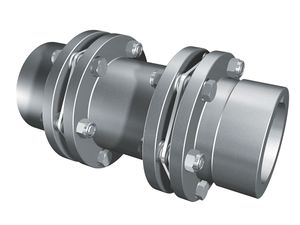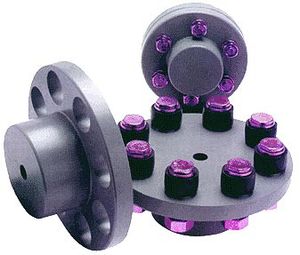Flexible Couplings
Flexible couplings are used to transmit torque from one shaft to another when the two shafts are slightly misaligned. Flexible couplings can accommodate varying degrees of misalignment up to 3° and some parallel misalignment. In addition, they can also be used for vibration damping or noise reduction.A coupling designed to allow a limited angular movement between the axes of two waveguides.
Types
The following types of flexible couplings are the most common.
Jaw Couplings
There are 3 types of jaw couplings: Straight Jaw, Curved Jaw and Jaw In-Shear . All couplings consist of three basic components: two hubs and one insert. The straight jaw couplings are the standard style and can operate in torque ranges from 3.5 ft-lb (4.7 Nm) to 170,004 ft-lb (230,233 Nm). Curved jaw couplings are similar to straight jaw, but the teeth of the hubs and insert are curved to accommodate additional torque. These couplings can transmit torques between 67 ft-lb (91 Nm) and 247,800 ft-lb (335,590 Nm). The jaw in-shear coupling is similar to the other two, but has an additional component. A locking ring is used to secure a split insert. The advantage of this style is the insert can be replaced without moving the two hubs. Jaw in-shear couplings can transmit torques from 335 ft-lb (454 Nm) to 183,333 ft-lb (248,284 Nm). All of the jaw type couplings can accommodate angular misalignment up to 1°.
Gear Couplings
Gear couplings use gear teeth to transmit torque from one shaft to another. The coupling accommodates misalignment through the clearance between the inner and outer gear teeth.This allows for the coupling to transmit high torques at high speed when the coupling is balanced. The coupling can transmit torques from 2,500 in-lb (208 ft-lb or 282 Nm) to 47,269,000 in-lb (393,908 ft-lb or 533,462 Nm) and has an angular misalignment capacity of 3°.
Grid Couplings
Grid couplings use two slotted hubs with a steel grid running between them to transmit torque. The coupling flexes by allowing the grid to slide along the slots in the hubs. Grid couplings can only accommodate 1/3° misalignment and transmit torque from 422 in-lbs to 2,700,000 in-lb (3,656,555 Nm).
Fluid Couplings
Fluid couplings are not necessarily a type of flexible coupling, but are used in association with flexible couplings. Fluid couplings allow motors to start up under a low load. The fluid coupling uses two wheels and an outer shell to transmit torque. Because the coupling transmits the torque hydrodynamically, the coupling also provides overload protection and shock absorbtion. A flexible coupling is added to a fluid coupling to allow for misalignment.
Torsional Couplings
There are many different types of torsional couplings. Most couplings use a rubber element to transmit torque between two hubs. The rubber damps any vibrations moving from one shaft to the other. Torsional couplings are made to adapt to shafts, flywheels or universal joints.

